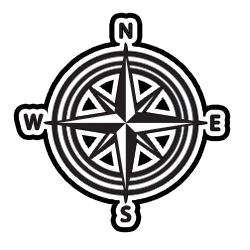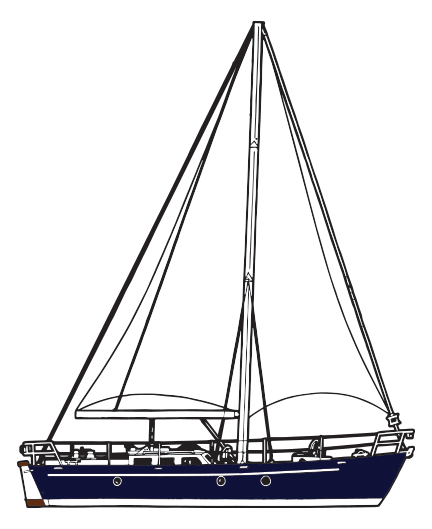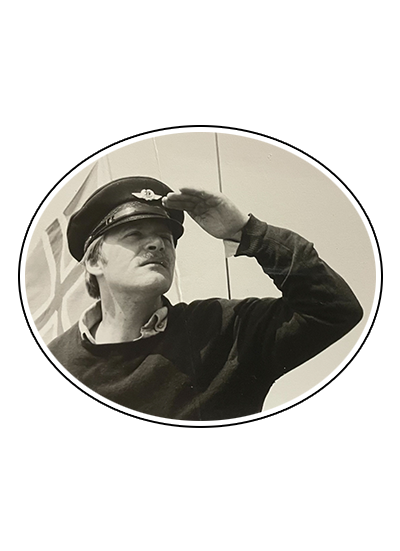Introduction
The Armchair Sailor & The Beach Leopard is a thesis about a son connecting to his late father. This son is me, Einar. To explain what I mean with the title, an armchair sailor is someone who doesn’t know how to sail, but knows a lot about sailing, and a beach leopard is a snow leopard that has adapted to a warmer climate. I am the armchair sailor and my father’s boat Drífa is the beach leopard. This may sound funny, but you will understand later in the story what this reference is referring to. For in this thesis, you will depart from Iceland to countries such as Morocco, Algeria, Niger, Nigeria, Cameroon, the Central African Republic, and Angola. Sail to Holland, to the Shetland Islands and to the Faroe Islands. From the Canary Islands to Cape Verde, to Brazil to Argentina, in search of ways to bond with a person who passed away a long time ago. The main concerns of this thesis, are mourning, bonding posthumously, through objects and adventure. Through the four chapters of the text, we learn about the origins of my father’s adventures, we learn eventually where Drífa the sailboat was built, where she travelled, stopped, and ultimately ended up. Afterwards we go to the time between the selling of Drífa and my father’s death, speculating of the future of where his life could have led, had he had more days to live. Finally, we will go into the challenging questions of mourning, dealing with death and confronting it. As you go through this thesis, I will do my best to guide you as my father guides me, I draw and paint maps, and imagine scenes from the trip on the African continent and other countries, show photographs of his sailing adventures; an emotional mapping of sorts1 1. Bruno, Giuliana. Atlas of Emotion. Verso, 2002. .
Because this thesis will mainly be about my father’s boat, I should introduce the owner and give you some information to go with the story of Drífa. Guðmundur Thoroddsen was born in Reykjavík in Iceland on September the 17th 1952 to his parents Drífa Viðar, a painter, writer, and educator and Skúli Thoroddsen an Opthalmologist (an eye doctor). He grew up in Reykjavík for most of his childhood, but at an early age he was sent to a farm called Staður in Reykhólasveit (which is located in the North-western part of Iceland). In Iceland kids would often be sent to spend the summer on farms away from their family. There could be various reasons for this, usually but not necessarily because of some trouble at home, or the parents being overwhelmed. He felt connected to the place and considered it his second home, the farmers and their children took him in as one of their own. Guðmundur studied art, painting, etching, and drawing in Iceland, France, and Holland from 1974 – 1985, in the Reykjavík School of Visual Arts, Sorbonne University in Paris and the Rijksakademie van Beeldende Kunsten in Amsterdam. His works varied in media, he made sculptures, paintings, prints, and various sorts of art. Most often the art was of folk tales and storytelling in general. His mother Drífa died of an illness in 1971 and his father soon after in 1973, leaving him and his three siblings to fend for themselves, the oldest brother being 25 at the time. I believe his desire to travel and “escape” most likely started from this rough period. Guðmundur named his sailboat after his late mother whom he was very close to, and she would be a big part of his life from 1980-1992 for almost twelve years. Before the boat was even an idea, Guðmundur went on a life changing adventure.
Vino, Cantina, Amigos
Iceland – England – France – Spain – Morocco – Algeria – Niger – Nigeria – Central African Republic – Zaire (now DRC) – Cameroon – Angola – Iceland
In early winter, January 15th in 1973, Guðmundur and his best friend at the time Þorbjörn Magnússon (Tobbi) travelled to England by ship, aiming to reach Northern Africa and the Sahara Desert . Guðmundur was invited by the state radio of Iceland (RÚV) to tell the story of their travels almost ten years after the trip in 1982/1983. His sister Theódóra (Góa) had sent me a copy of the program. In it, he begins by talking about a game they played on board the ship to England.
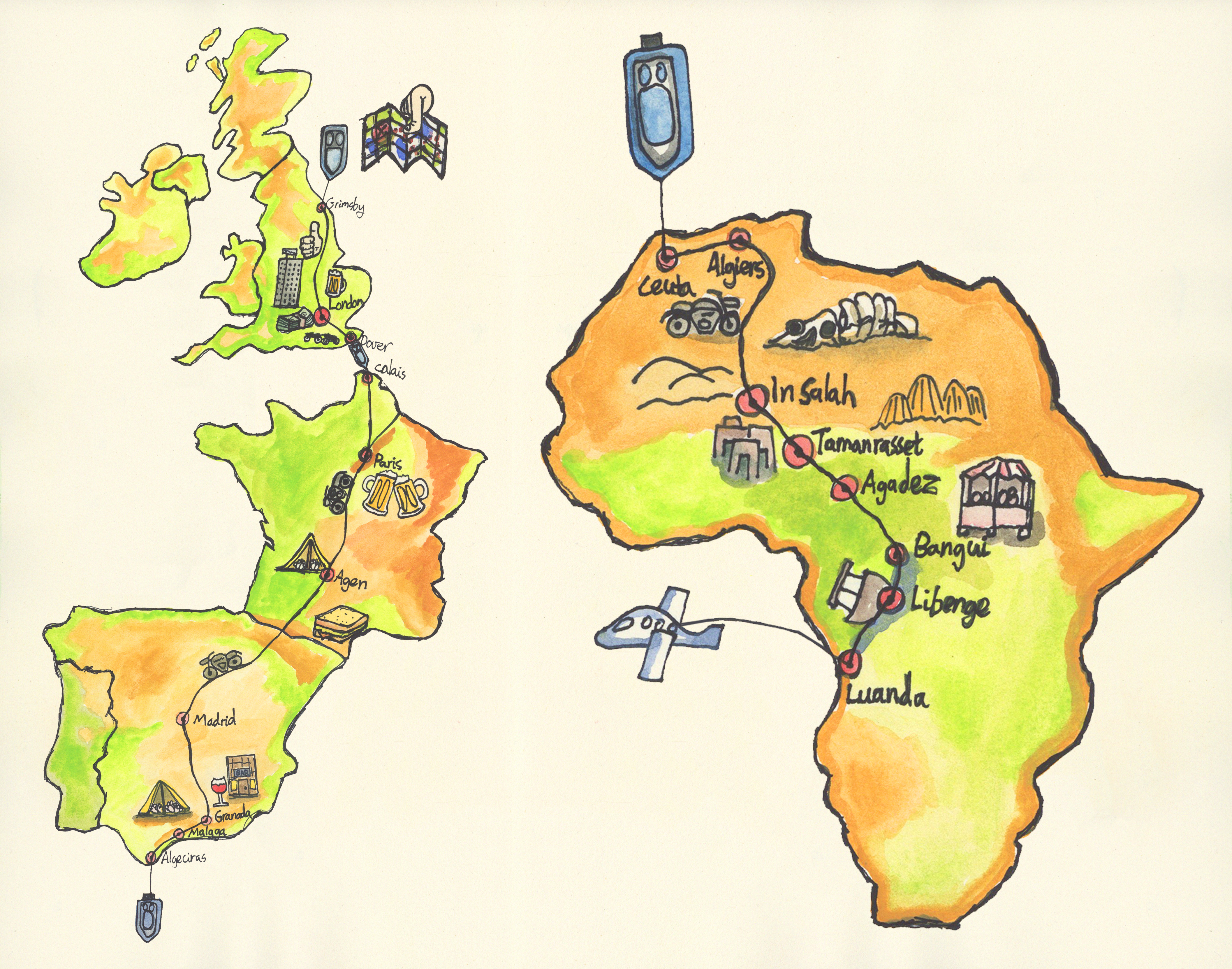
” England, France, Spain, Africa”, Einar Viðar Guðmundsson, 2023
It was a game of picking places to visit by blindly pointing to locations on a map. Their first location was Birni-N’Konni, a town in the Tahoua Region of Niger, lying immediately north of the border of Nigeria. They found the name Birni-N’Konni interesting. When they arrived in England and made their way to London. The evening before they continued their way to France, they meet a man that told them their trip through Africa might be more exciting on motorcycles. The next day they purchase motorcycles, having no clue how to drive in the city traffic of London and barely making it out alive. That was just the beginning.
"I had never heard my father’s voice before and as I listened to the audio recording, his voice felt familiar. It was as if I had always known what it sounded like, but it didn’t really resemble anyone’s voice that I knew. While I listen, I draw and paint the images that come to mind from the journey."
They travelled down through France making their way to Spain, meeting all kinds of strange and funny people. Especially a man they met one evening in Granada, who kept talking to them in Spanish, which they didn’t understand, until his sentence was reduced to three words, “vino, cantina, amigos”. For those that don’t speak Spanish this means wine, bar, friends, I’m sure you can guess how that evening went. Guðmundur and Tobbi made their way through Madrid, Granada, further down Spain taking a ferry from Algeciras to Ceuta, a Spanish city bordered to Morocco. In Ceuta, they slept in their tent up on a hill, not too far away from a military base and just as they were falling asleep, they get startled by loud noises and screams. Outside their tent stood a dozen armed soldiers pointing their guns at them speaking angrily in Spanish. Thankfully Guðmundur and Tobbi could explain the situation that they were travellers and not spies or drug smugglers. After this somewhat warm welcome, their destination was Tangier. They met a group of fellow travellers and decided to join them on their journey through the Sahara Desert. Their evenings would consist of bonfires in the cold nights, with exchanges of stories, some funny, some informative, others scary and uncomfortable. Those stories were of people who had been killed during their travels in Morocco, stories you surely don’t wish to hear at the start of your journey.
The other travellers were on a big jeep, which of course had more gasoline in the tank than Guðmundur and Tobbi’s bikes. They started to run low on gas and had found a small town 100 kilometres away on their map and thought they could go there, fill up and meet the other people again. Sadly, they had already made it further into Algeria and were long gone. Now they were on their own again and made their way to the city of Oran in Algeria. In Oran they searched for their former travelling partners, asking some locals if they had seen their jeep, a young man thought he had seen it the day before, but that didn’t help. From Oran they went to Algiers stocked up on supplies and prepared to go the rest of the trip alone, having given up on finding the jeep.
While driving over the Atlas Mountains, the headlights of one of the bikes started to malfunction. Luckily, they could partially follow a truck making its way down. The mountains could be very cold during the night. The weather got warmer the further down they went, and to their great happiness, the roads were smooth asphalt as opposed to the sandy patches of rough roads they had been driving on. Their bikes however began to make weird noises and sounds of all kinds, they needed to be repaired. The next stop was In Salah, from there the roads got worse, but they were determined to make it to Tamanrasset the final city in Algeria before the big desert.
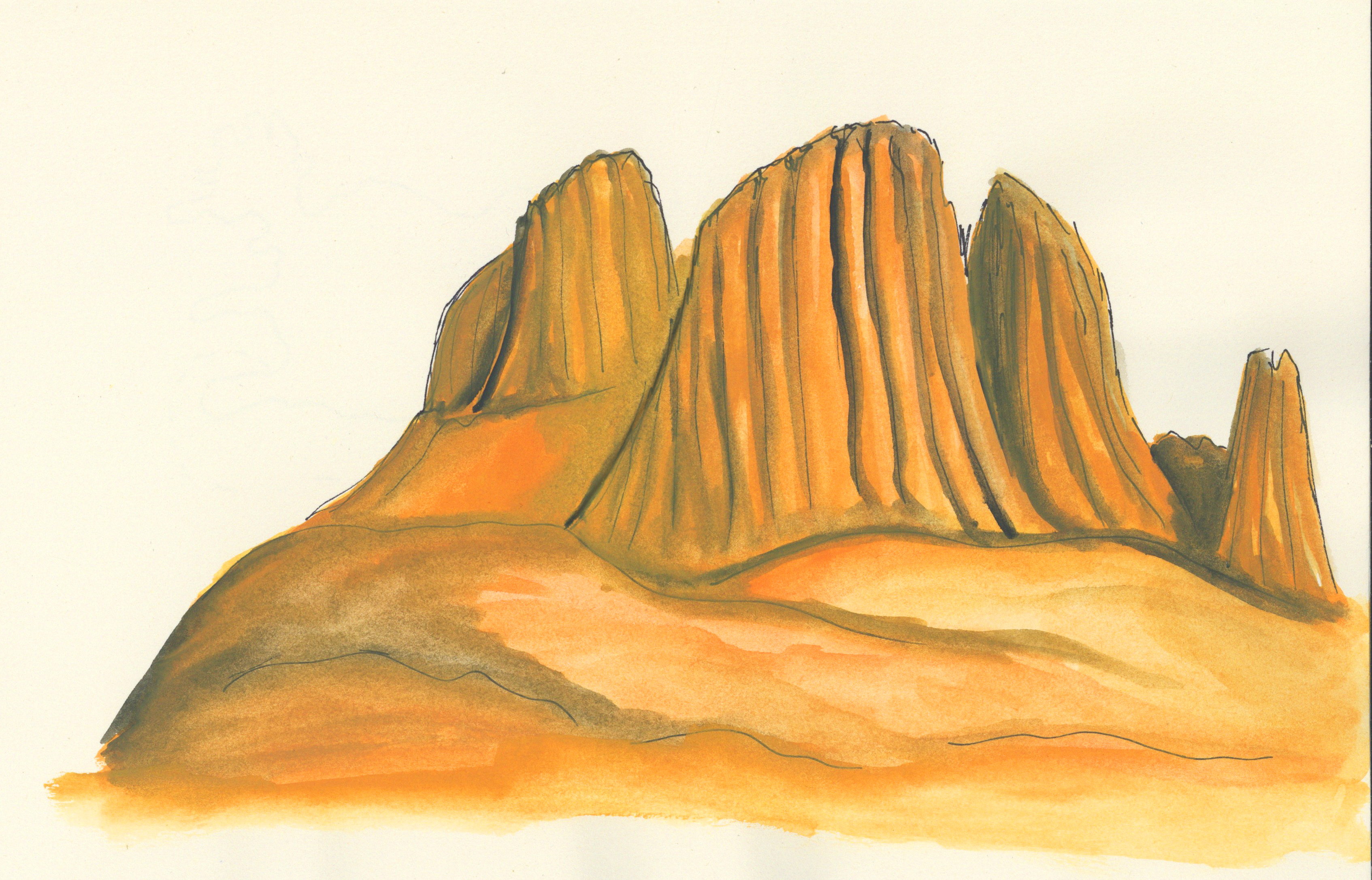
“Hoggar Mountains”, Einar Viðar Guðmundsson, 2023
As they drove, all around them was beautiful scenery. The Ahaggar National Park surrounds the area with great big rocks and intense colours of red, yellow, and orange, completely different to the mountains of Iceland. In Tamanrasset they met a group of Englishmen, who delivered a message to them from the jeep people giving their regards. Guðmundur and Tobbi decided to join the Englishmen. With them was a Danish man who coincidentally was a motorcycle repairman. He fixed their bikes as best as he could. The drive from Tamanrasset to Agadez was partly roads, big distances of only sand with long sticks in the ground leading the way and big piles of loose sand, making it easy to get stuck. When it was time to sleep the men would either lie under the cars or put their bikes together to make a makeshift tent. On the roads lay skeletons of camels, abandoned cars and empty tents, stark reminders of the reality of sandstorms which these lands were prone to.

“Skeleton, Abandoned Car and a Tent”, Einar Viðar Guðmundsson, 2023
After a few days travel the men found a well and approaching it was a long line of camels. That night they joined the owners of the camels for tea, the evening was relaxing and nice with the conversations mostly going by hand gestures and sounds, but they managed to understand each other just fine. Five days passed and they made their way to Agadez which is a town in the centre of Niger. The people there live in tents and the surrounding areas are only sand, very dry and have barely any vegetation. The following day the air felt thick and peculiar, a weird feeling floated around the town and all of a sudden, a stroke of lightning roared and bucketfull’s of rain came pouring down. This was the first rain in three years. The townsfolk rejoiced and started gathering water in buckets to bring home.
Guðmundur and Tobbi continued their journey and saw a sign with the name Birni-N’Konni, the town they originally planned to visit. It was a few kilometres away, but funnily enough they just didn’t bother going there, and instead continued towards the city of Bangui in the Central African Republic on the border to Congo. At that time Bokassa the president before he became the self-crowned Emperor of the Central African Republic, was reigning. He had just introduced very strict laws towards thieves; first offense meant losing an ear, second offense meant losing a hand, and a third meant death. Despite poverty and a scary leader, Bangui was very lively with all sorts of markets, fresh fruits, and the alike, the men explored and took in the culture. They had stopped in the city to sell their bikes. After a few more days both Tobbi and Guðmundur got Malaria and had to stay in their tents for days without being able to eat or move, they gradually got better, and continued trying to sell their bikes. However, no luck seemed to be found selling them, and they were forced to trade other possessions, such as their tent and some objects they had with them. After a few days someone finally purchased their bikes, but now they would have to replan their trip.

“Bangui Market”, Einar Viðar Guðmundsson, 2023
Shortly after, a German man by the name of Klaus stroke up a conversation with Guðmundur, they talk about their plans and decided to travel together. Their aim was to row down the Ubangi River, through Congo to Angola. They met two fishermen and tried to buy their boats, but they wouldn’t sell them. Instead, the fishermen pointed them in the direction of where they could buy boats and Tobbi, Guðmundur and Klaus went, bought two boats, nailed them together and went on their way, excited to get out of Bangui.
The Ubangi River was host to many insects and animals. The men had been warned by the locals to not go on the banks too early and not sleep too long, since the whole area is home to many crocodiles who stay on land during the night and swim during the day. Singing birds, croaking amphibians, and chirping bugs could be heard all around, occasionally the men would jump in the water to cool down. The river was magnificent, the surroundings beautiful, and they would find themselves staring at the beauty of the river. One morning they met a local man on the water bank by the name of Antoine who spoke a bit of French. Guðmundur spoke very limited French but could converse a with him. He asks if he can get a ride to Libenge a town 50 kilometres away, they oblige and decide to help him out. They park their boat on an island to sleep, noticing that there are other boats coming next to them, which they don’t like. There is a bit of tension in the air, until a grey-haired man comes over with chickens in a cage, speaking to them, but they don’t really understand. Luckily Antoine could translate, and they negotiated some canned food they had for the chickens, however somewhere the translation had been misunderstood and they instead got four eggs. Not wanting to make a fuss, they accepted the eggs, since they hadn’t had eggs since Spain months ago. They boiled the eggs after the men had left and every single one of the eggs was rotten, black, and smelled awful, the men just had a little laugh about it and continued on their way.

“Ubangi River”, Einar Viðar Guðmundsson, 2023
Continuing down the river they stop in Lebenge to drop off Antoine and for a doctor’s visit, because Guðmundur had gotten an intense headache and lost his hearing on his right ear. After a few hours at the hospital and a penicillin syringe later, they left to go on their boat, but the boats had been destroyed, and there was no way to repair them. The men were stranded there for three days, but thankfully were able to take a ferry to Angola, which sadly became their last stop on the trip. The journey took them eight months, from January to September. They likely would have travelled further, but Guðmundur received news that his father Skúli Thoroddsen had passed away on August 23rd, so they packed up in Angola and made their way home.
"I had heard about the trip to Africa, but never in this detail. While I listened to the audio recordings, I explored Africa on Google Maps and pinpointed the roads, villages, towns, and cities he stopped in and passed by. It felt as if I was there with him, feeling the excitement, the struggles, and to hear his voice telling it all was something I never thought was possible."
Their journey in Africa would stay on their minds for the years to come. The thoughts kept on pushing them further towards their dreams of building their own sailboats, a dream they pursued in Copenhagen, Denmark in 1980.
Drífa, the Sailboat
“… the engagement with sailing of most sailors as well as small, amateur and, sometimes, semi-professional boat builders is no longer a practical matter, one focused on efficient production and work, but a leisure activity focused on pleasure.”2 2. Williams, James C. Sailing as Play. The International Committee for the History of Technology (ICOHTEC), 2013
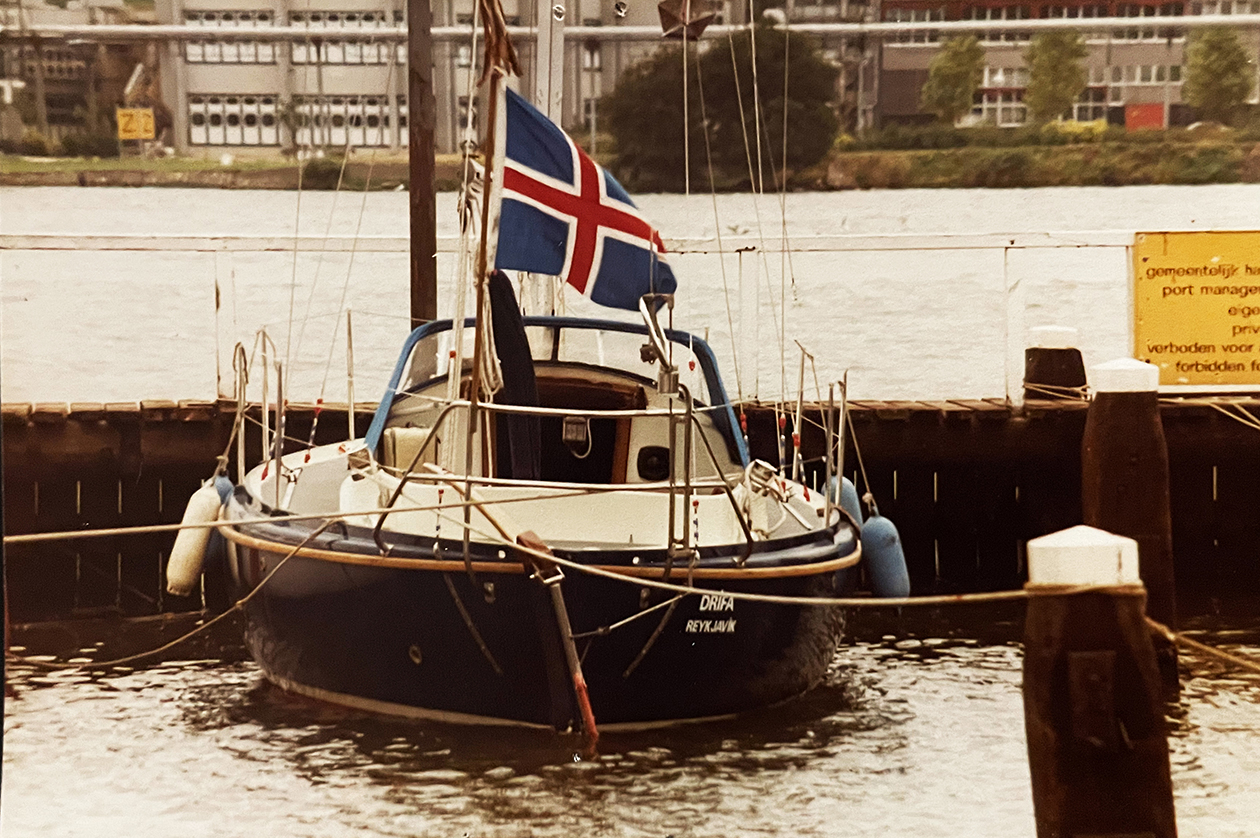
Drífa docked in a harbour in Amsterdam
Drífa had many friends, visitors, and acquaintances. She would often invite them to sail the Northern Sea and the Atlantic Ocean for long distances and for short. The boat had a dark navy bottom, 10 meters long with a single sail, with wooden interiors, a sink, bathroom, leather seats, and a bed.
"I had only heard about Drífa before. To my memory, I had never seen photos of the boat. During the start of my journey, I had been searching for any kind of photographs related to my father’s adventures in the basement of my childhood home without any luck. Just before I leave the basement empty handed and disappointed a tiny accidental nudge of my shoe pushes a box into view. A box filled with photos of Drífa, my father, his friends, family, and everything I was looking for. It was as if someone had guided me towards the box. I open it and begin to shift through 20-30 packets of Kodak films and pictures, dating back to the year 1980 up until 1995. I weave together the story of the creation of Drífa and her travels with my father and his friends."
Construction of Drífa
Þorbjörn Magnússon (Tobbi) and his partner at the time Unnur Þóra Jökulsdóttir wrote the book Kjölfar Kríunnar3 3. Jökulsdóttir, Unnur Þóra & Þorbjörn Magnússon. Kjölfar Kríunnar. 1989. together and it was published in 1989. In the book there is a chapter that mentions the construction of two sailboats Drífa & Kría. Tobbi writes about how coincidentally both him and Guðmundur had felt the itch of boatbuilding since they had to ditch their motorbikes in Africa and sailed down the Ubangi River. Tobbi writes “Now me and Guðmundur haven’t seen each other in a few years, both in separate countries and never so much as a word about sailing between us. What an odd coincidence that we should both have gotten the same longing for it, perhaps both infected by an African river virus.”
"From what I gathered and heard; my father was always a great builder. His sister Theódóra told me that he would say of himself that he was “just good at fixing things that had become a mess”."
In the book The Craftsman4 4. Sennet, Richard. The Craftsman. Yale University Press, 2008. Richard Sennett argues that the spirit of craftmanship involves the so-called “desire to do a job well for its own sake”. “Craftsmanship is a vital human activity, an activity that creates things that are not only useful but also beautiful and emotionally resonant. It is an activity that engages the mind and the hand, and it is an activity that is deeply rewarding in and of itself.” Meaning that people that create or craft only for glory and competition do not tend to produce the same quality work as those motivated by a proper sense of craftmanship. The book is a response to the philosopher Hannah Arendt and her darkened view on manual work. She argued that labour was only a necessity for meeting basic needs, but not a production of lasting artifacts or an expression of human uniqueness, therefore she sees labour as a dehumanizing activity if labour is a focus in a person’s life. Sennett reminds us that taking pride and time to do something well for the sake of quality isn’t necessarily a bad thing, but something to cherish. This can be applied to both Guðmundur and Tobbi, as their quest for building their boats comes from the desire to craft something of importance to them emotionally, most likely from their time spent together in Africa.
Despite not having much contact over the years; they both moved to Copenhagen to construct their boats Drífa & Kría. In the beginning they gathered texts, books, images, materials, and essential equipment, whatever was needed to make the boats. In boat design the preliminary considerations are as follows: Choice of boat-type, intended use and main dimensions, once you have an idea for each, you can start with building5 5. Larsson, Lars & Rolf E. Eliasson. Principles of Yacht Design. Adlard Coles Nautical, 2000. . Since they hadn’t owned nor built boats before Tobbi and Guðmundur referred to themselves as armchair sailors.
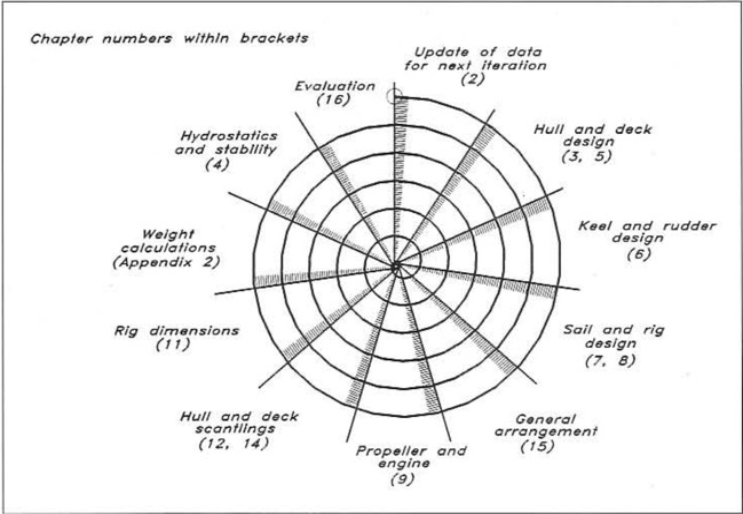
Design Spiral from Principles of Yacht Design.
Drífa and Kría did not differ in size, Kría was a light-blue bottom with red sails, and Drífa a dark navy bottom with white sails. After finishing building the boats in 1982, the two friends Tobbi and Guðmundur parted ways with their brand-new boats, ready for adventures across the ocean for many years to come.
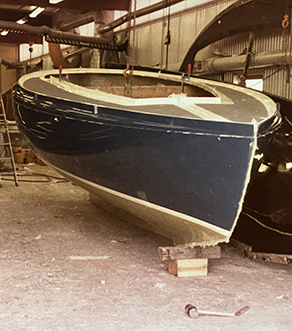
Kría mid-construction.
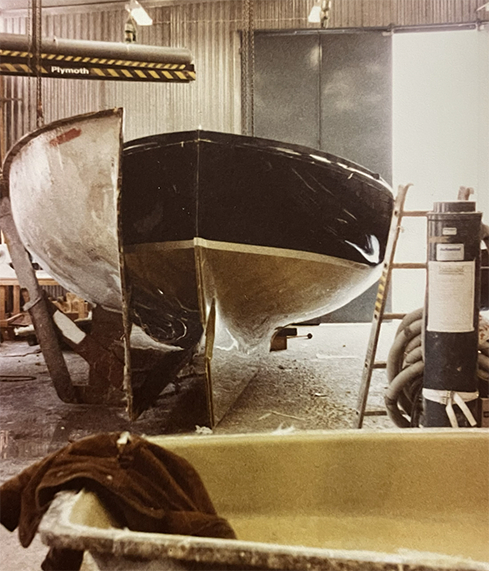
Drífa mid-construction.
From Amsterdam to Iceland
Drífa’s first proper adventure on the sea was in 1983, when Guðmundur, and his friends Garðar and Jón sailed from the ports of Amsterdam to the Shetland Islands in Scotland, from there to the Faroe Islands, ending up in Iceland. The journey was not only a bonding moment for the friends, but also for Drífa — this was a chance for her to show what she was made of, a bonding moment between the owner and the boat. Drífa was prepped with supplies in Amsterdam with water, wine, food, clothes, soap, more clothes, and good company. They made their way through the docks to the North Sea to begin their journey. Weather conditions were bad for the first and second leg of the trip, but Drífa plunged through the open sea and sailed roughly a thousand kilometres towards the beauty of the Shetland Islands. On the way there the crew members of the boat drank, laughed, played harmonicas, and took shifts steering and making sure they sailed the right way. Things seemed to be going quite okay besides strong headwinds and heavy rain, the mood on the boat never changed. After a few days of sailing, they made it to the islands and took in the scenery. Drífa stayed on the dock and held watch over the supplies, while the crew explored the islands, taking photographs and speaking to the locals.
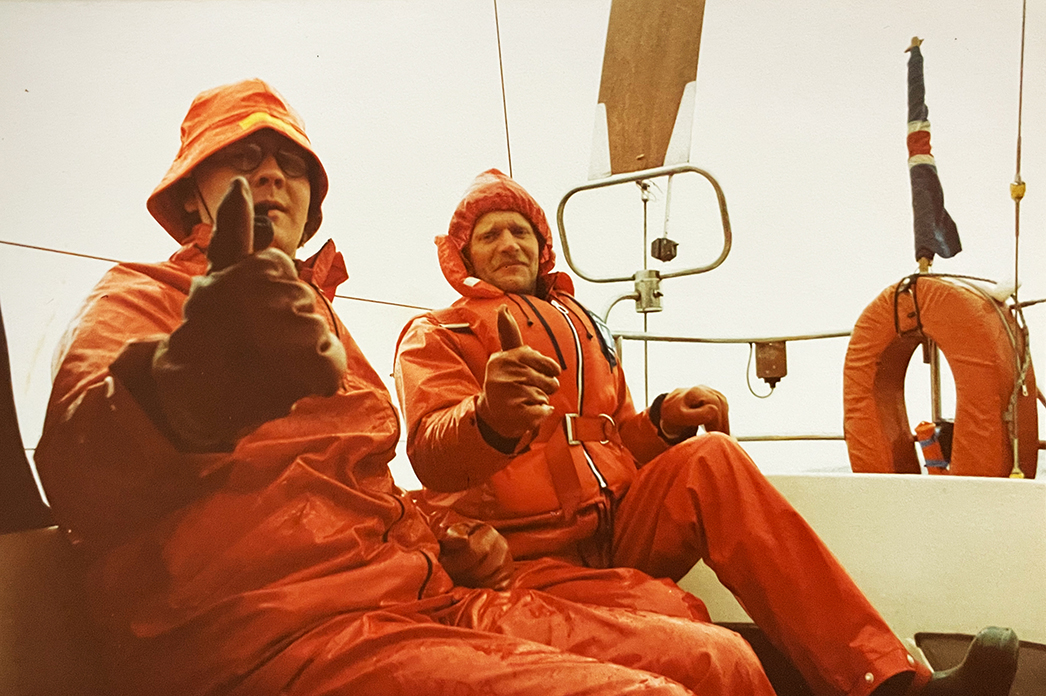
Jón Sigurpálsson & Guðmundur Thoroddsen in transit to Faroe Islands
After they had their fill of walking on land, the crew returned to Drífa and headed for the Faroe Islands, seven-hundred kilometres away, resupplied, and ready to tackle whatever the North Sea had to offer. Just as the image of the town disappeared behind them through the fog, the weather continued to be a nuisance. The story was the same, strong headwinds, heavy rain, and overall bad conditions for effective sailing. Persistence was key however, and surely enough they made their way to Torshavn, the capital of the Faroe Islands. The men explored Torshavn and Drífa stayed at her post in the harbour, protecting their belongings. Jón decided to get off there and made his way to Iceland differently. The rest of the journey from Torshavn to Reykjavík went smoothly, with less headwind and rain and better conditions overall. What was only 8-10 days of travelling from Amsterdam to the Faroe Islands felt to Drífa and the crew like 3-4 years, but that didn’t stop them from finishing the trip to Iceland. Drífa had proven herself a sturdy and good boat, ready to face whatever the sea could bring.
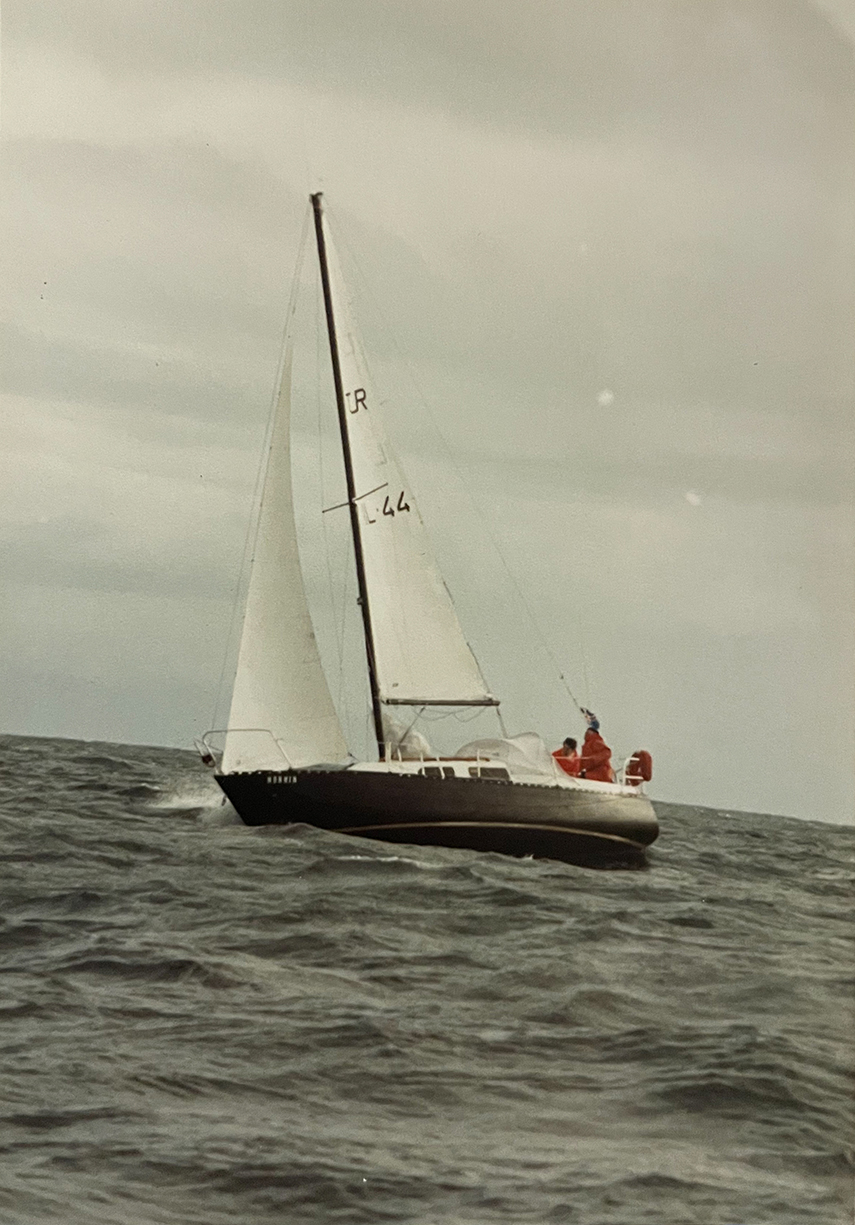
Drífa on the North Atlantic Ocean
From Spain to South America
From 1984-1991 Drífa went on a few adventures here and there. One particular trip was to the Canary Islands, where Drífa was docked for a few months until a family friend, Karl Gunnarsson (Kalli), a marine biologist and deep-sea diver, amongst others, had planned to travel with her to South America in 1991. The plan was that Guðmundur would meet him there and take Drífa to the most Southern point of the continent. Kalli had docked Drífa in a town called Marina Jacaré Village in Brazil, and she waited for Guðmundur and Jón Ottó Gunnarsson (brother-in-law) to take her for yet another adventure. Kalli met them, said his goodbyes and Jón Ottó and Guðmundur supplied Drífa with everything needed for sailing. Weather conditions were excellent, strong winds and sun bursting through heavy clouds in glimpses throughout the day. Drífa sailed the Atlantic Sea with ease, stopping in a few towns along the way to refuel and gather more supplies.
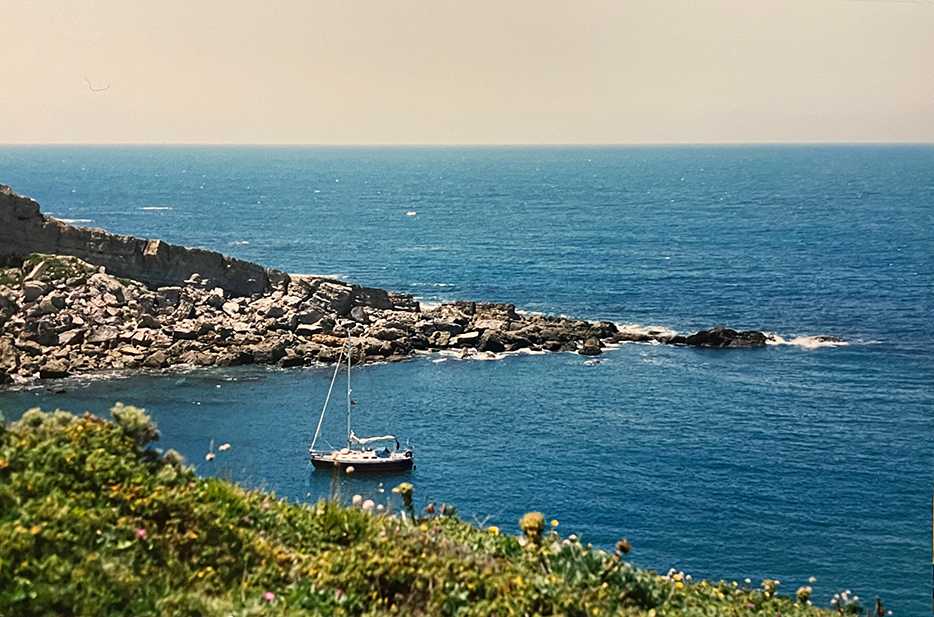
Drífa on the Spanish coast.
Elísabet Gunnarsdóttir (wife of Guðmundur), Jón Kolbeinn Guðmundsson (their first-born son) and Gunnar Jónsson (father-in-law) had travelled to Buenos Aires to wait for Jón Ottó and Guðmundur, so that they could celebrate Christmas together. The original plan was that they would arrive earlier, but when they were close to Buenos Aires, Drífa’s motor stopped working, and the nightmare of all sailors set in; nice weather. Extreme heat and absolutely no wind, Drífa stood still, a mere 100 kilometres outside Buenos Aires, with time slipping away very slowly. After what felt like decades, small gusts of wind caught Drífa’s sails, and the trio got back on track. They managed to make it to the ports of Buenos Aires on the day of Christmas Eve, to a welcoming party of their family. Jón Ottó, Elísabet, Jón Kolbeinn, Gunnar and Guðmundur celebrated Christmas and New Years in Buenos Aires while Drífa rested on the docks. The trip had been challenging, but after a week or two, Drífa faced yet another challenging trip, where her life would take a turn.
Drífa, and the Butcher in Argentina
Elías Skaftason (Elli), a fellow sailor and friend joined Guðmundur and Drífa, heading to the lowest point of South America, namely Cape Horn. Guðmundur had plans to do an art project in Patagonia at the time that never materialized. Elli and Guðmundur began sailing from the ports of Buenos Aires, made their way down, until a wall of black and angry clouds roared and growled at them in the distance. Startled they began to prepare for the worst as the darkness propelled towards them. Drífa held her ground, nearly tipping over and sinking, but she managed to hang on. There isn’t much you can do to prevent a situation like this, except hold on to the hope that the boat doesn’t tip over. After the dangerous storm accompanied by thunder and lightning had passed, Guðmundur and Elli sailed Drífa to a town called Mar Del Plata, the second biggest city in the Buenos Aires region. She didn’t know it, but this would be her last trip with Guðmundur.
With a heavy heart, Guðmundur decided to sell Drífa. It was not an easy decision, and it would be something that he would regret for the years to come. Since he named the boat after his late mother, one might say that he lost his mother twice. His life was filled with laughter, joy, but beneath it all there was a strong mourning for his mom. An Argentinian butcher in Mar Del Plata had shown interest in Drífa and after talking to him Guðmundur decided that he should be the one to have her. He said his goodbyes to Drífa and went on his way home to Iceland to the embrace of his wife and first-born son. Drífa the snow leopard had migrated to a warmer climate to become the Beach Leopard, residing in the harbours of Argentina still to this day .
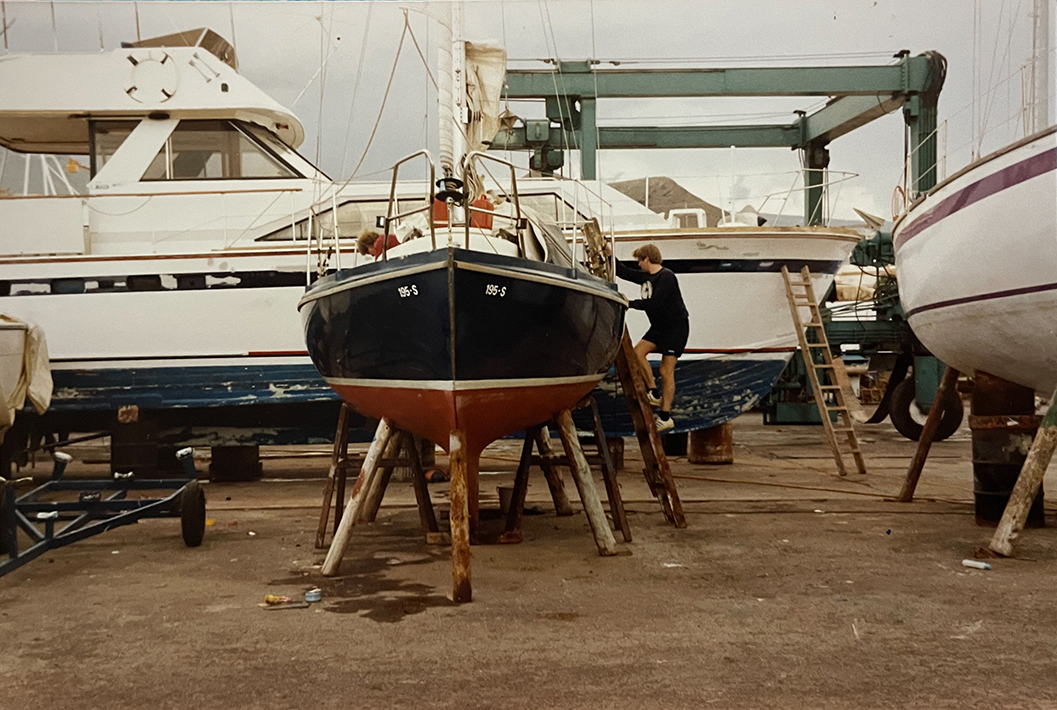
Guðmundur leaving Drífa in Spain.
The risk6 6. Vester, Heinz-Gunter. Adventure as a Form of Leisure, Leisure Studies. Temple University Libraries, 2006 of death is always a concern for sailors, thankfully my father and Elli were lucky enough to weather the storm, but the Dutch artist Bas Jan Ader7 7. Dumbadze, Alexander. Bas Jan Ader: Death Is Elsewhere. The University of Chicago Press, 2013 wasn’t so lucky. He disappeared while trying to sail his 4-meter-long sailboat from the West Coast of the US to Falmouth in England. His disappearance caused much speculation as he sailed alone across the North Atlantic Ocean. His shipwreck was found on the coast of Ireland, but not his body, leaving no closure for his family regarding his whereabouts, a terrible situation when mourning someone’s absence.
Dreams, Death & Sorrow
A few years before selling Drífa, Guðmundur had envisioned starting a tourist company that would offer tourists trips on a sailboat to various locations around the Westfjords of Iceland, offer hike tours and all kinds of camping. Since Drífa had been sold, he planned to build a new boat that would be used for that company. A bigger boat made of steel, specially designed for cold climates with more room for guests. He got as far as the body of the boat when suddenly, he couldn’t work on it any longer because he fell ill and passed away shortly after.
“Death is an object which contains nothing but absence, an empty something – an emptiness of individuated life. But this empty something remains present in the world, in the physical universe, in the human, animal, social, historical, and symbolic universe”.
This quote from Form and Object: A Treatise on Things8 8. Garcia, Tristan, Mark Allan Ohm & Jon Cogburn. Form and Object: A Treatise on Things. Edinburgh University Press, 2014 argues that death is both an absence (end of life) and a presence (physical, symbolic impact). The void created by death remains present in other forms, such as the objects left behind, such as my father’s unfinished boat.
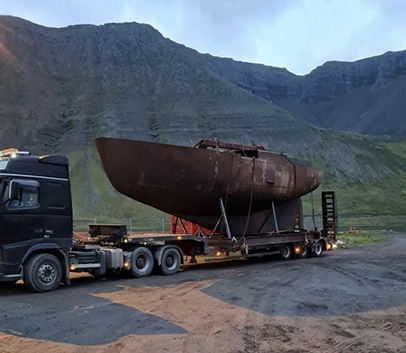
Drífa 2.0.
In the past I have always felt sad when seeing the unfinished boat. It is a bitter reminder of the life I didn’t get to have, the parent I was missing. Feelings of longing for that life would sometimes become overwhelming. As I get older and look at the boat it reminds me of my father’s existence and of mine. In this unfinished story lies his knack for craft, wishes and dreams. They flow through my veins, as do his bodily features and yearning for adventure. With time the boat decays, its patina showing traces of time. It is almost my age, we age together. It remains in what my father would call “home for the remainder of his years”, Ísafjörður. There was hope that the boat could be finished by me and my brother, but that plan never materialized. Thus, it is awaiting to be finished, like an unwritten script, filled with potential adventures, hardships, bonding, laughter, and storms.
According to Elisabeth Kubler-Ross and David Kessler the five steps of grief are denial, anger, bargaining, depression, and acceptance, at least that is what they write in their book On Grief and Grieving99. Kubler-Ross, Elisabeth & David Kessler. On Grief and Grieving. Simon & Schuster, 2005.. The book was heavily criticized for its narrow view on grief and understandably so, because it’s crazy to say there is only one way that grief is dealt with, and that leads us to the last chapter.
Mourning Routine
Mourning comes in many different forms. I often find myself mourning the loss of my father, even though I may not always recognize it. When I was younger, I felt a void but didn’t fully understand it. I never had a stepfather or anyone to fill that role, and I recall feeling envious of those who had both a biological father and a stepfather. From a young age I was always looking for this figure in different people, but with this thesis I am solidifying my dad as the long-lost father figure and coming to terms with his death. I do this by the ways that I and those around me mourn him in different ways.
In 2012, my mother started a tradition of celebrating my dad’s birthday. When he would have turned 60 years old, she invited friends, family and acquaintances for dinner, music, speeches, and drinks. This birthday celebration was something I enjoyed, but didn’t really understand, because it felt weird to celebrate his birthday when he wasn’t there and never had been. As the years passed, I began to understand the point of it, to celebrate his life, even looking back on that birthday celebration fondly. In 2022, my mother, brother and I took the celebration even further. We decided to have an exhibition of his works on each floor of our home in Ísafjörður. The show opened on August 2nd with hundreds of guests attending and ran until the 17th of September which would have been his 70th birthday. On that day, we held a big dinner party where many old friends, cousins, and acquaintances showed up. Songs were sung, music was played, and stories were told. It was truly a magical evening and to see the amount of people still remembering and keeping his spirits alive was a moment I won’t forget. This tradition has in a way replaced mourning with the celebration of his life.
Lia Haraki, a choreographer from Cyprus, dealt with her grief and the unexpected passing of her father by creating a dance theatre piece called Monday Mourning. Her work is a comment on mourning and how we express it differently. “... With the death, abandonment, or separation of a loved one, reality as we know it changes and that is why we mourn. The time we take to mourn is the transitional period before we get used to our new reality.” She pays tribute to her father through his music, dance, and his positive outlook on life. There are five characters in the performance, each one dealing with grief in their own way.1010. Cools, Guy. Performing Mourning: Laments in Contemporary Art. Valiz, Amsterdam, 2021 To me our tradition of celebrating my dad’s 60th, 70th and in the future his 80th birthday is in a way a communal life celebration performance, where those who knew him kept their version of him alive through words and presence.
Furthermore, photographs serve as powerful tools for mourning, I could even say one of the most powerful. They offer glimpses into memories and moments that can otherwise be difficult to hold onto. Not only do they capture specific moments in time, but they allow for a deeper understanding and connection between the objects and individuals. Particularly when you have someone there to give you context and information about the photograph. In her book On Photography1111. Sontag, Susan. On Photography, Farrar, Straus and Giroux, 1977., specifically in the chapter called “In Plato’s Cave”, Susan Sontag examines the role of photography in shaping our understanding of the world by arguing that they provide a limited and often distorted view of reality. In the case of a son trying to piece together a story of his late father, photographs can be a sharp tool to shape and weave together moments of a time long passed. My grandmother, like many other people, has numerous photo albums filled with pictures of her family, friends and loves ones, passed and living. While I didn’t pay them much attention as a kid, I now find them to be a valuable source of nostalgia and emotional connection. A big inspiration for me choosing this topic for my thesis was the book Regarding you & me: Six attempts at getting closer to my father1212. Kuijper, Marijn. Regarding you & me: Six attempts at getting closer to my father, Self-published, 2019., by Marijn Kuijper. Marijn uses photographs from his childhood of him and his father, he takes photos of objects that his father has touched and used and makes comparisons of their smile, eyes, etc. His father passed away when he was three years old, and Marijn mourns the fact that he could never tell his father he was a trans man, and because he is now also becoming a father, he researches ways in which him and his father relate in the present. He makes this wonderful book, of their story together as a way of bonding with his late father. This project resonated with me, because I have always wanted to do something similar, and to take the steps towards such a personal subject, has really helped me understand, be at peace with ‘the void’, and to get closer to my dear old dad.
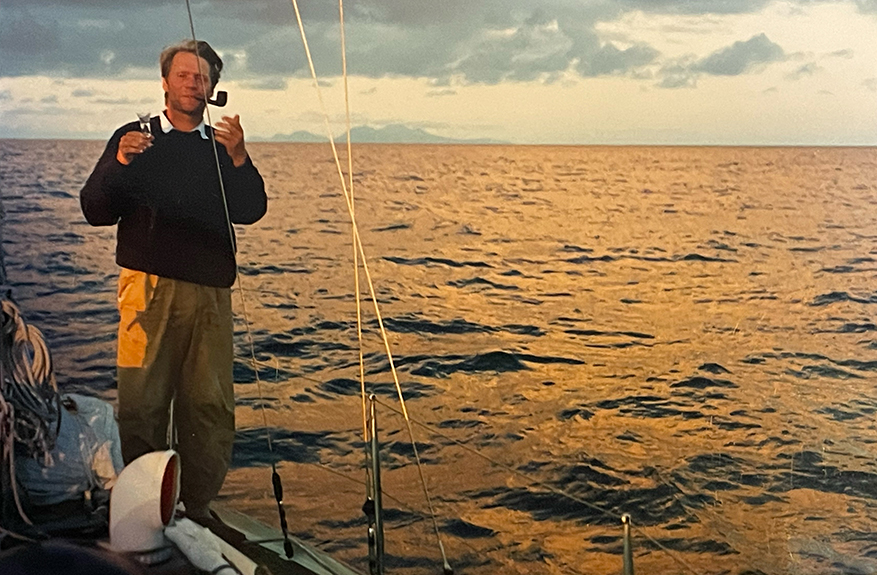
Guðmundur enjoying the moment.
The Armchair Sailor
& The Conclusion
Mourning someone that you didn’t get the chance to know is an indescribable feeling, all I have are photographs and stories. At the start of this thesis, I didn’t know what to expect from my research, but with curiosity at the forefront, reaching out and taking leaps of faith, I have come to know my dad better than I could possibly have imagined. When reaching out, to my great surprise I received countless phone calls, got sent texts from all kinds of people from the past, each with their own descriptions of my father and his presence. It seemed that everyone jumped at the chance to talk about him. In the process of writing, I have listened, observed, seen and explored the places, stories and photographs of my dad, his friends, and his boat Drífa. Through the phone calls, emails, photographs, maps, and speculations I have attempted to get closer to the man that was missing my whole life. This attempt has been one of the most rewarding experiences of my life. I would be lying if I told you it was easy, infact it’s completely the opposite. When dealing with a situation such as this, I found that the best way is to jump into the deep end, ask the questions you might have, maybe you won’t get all the answers and that’s okay, discover what is there, even if it is painful, because it will surprise, enlighten, and even strengthen you. I certainly feel enlightened and as if a burden has been lifted off my shoulders.
As I listen to the recording of my dad’s trip to Africa, I go on google maps and follow the path that he carves through the map for me. His voice guides me, and I feel as if I am there with him exploring, something I never thought possible, I laughed, shed a tear or two, and almost forgot that I was hearing his voice for the first time. In the archive of photographs that I found, I get introduced to Drífa, the boat that I had heard so much about, but never saw. The host of countless adventures and has been an object with which I have bonded with my father. Objects are a means of communicating with the dead, through the objects the dead can be made to speak, to tell their own stories, to reveal aspects of their lives that would otherwise remain hidden or forgotten. These photographs of my father, evoke a mix of longing for what could have been and the reality of the loss. They serve as a deeper understanding and proof of the life he lived. That I have someone that I can still look up to, despite us being almost total strangers to eachother. Though my view of his life may be distorted to the reality, as Sontag argues, the photographs are key to me getting to know him. What I find the most beautiful about this whole bonding experience, is the fact that he lived his short life to the fullest. He even leaves me with ways to find him, to look for him. Little hints and clues one could say. If I ever wanted to go on an adventure with him, one could argue that he already created maps for me to follow. I am now the Armchair Sailor, and the Beach Leopard waits for me – waits to be found again.

"A special thanks to those that took the time to talk to me. Reaching out, sharing their knowledge and whatever they could find, and to those who gave me advice and guided me. I couldn’t have done this without you, and I give you my sincerest thanks."
